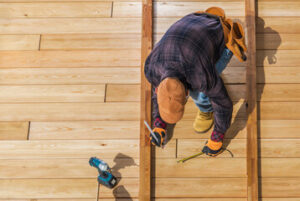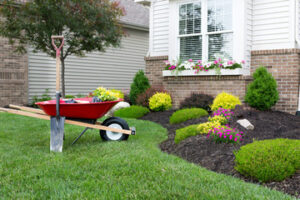Regularly inspecting your deck is key to identifying potential problems and fixing them before they escalate. Examine popped nails, loose boards, and hardware beneath the deck, such as joist hangers, and tighten or replace them.

Protect your deck from moisture damage by applying a sealant or stain every couple of years. Lightly sand the surface before staining to help the sealant adhere evenly. Contact Baltimore Deck Builders for professional help.
Debris clings to the surface of your deck, where it collects moisture and creates the perfect breeding ground for mold and mildew. Cleaning regularly removes these growths and reduces the risk of future damage. Sweep the deck to remove loose dirt and debris before you start cleaning. This prevents abrasive particles from scratching the surface of the wood, which can cause damage over time. It also helps you spot any areas where rot has begun to set in.
Regular sweeping removes most organic matter from the surface of your deck, but it can’t reach everything. If your deck is under the canopy of trees, it will collect leaves, pine needles and other debris that can clog the spaces between boards. If you let this buildup occur, it can lead to structural damage over time. It can also cause the boards to rot more quickly.
In addition to sweeping, you should remove any plants and furniture from the deck. It’s also a good idea to trim surrounding vegetation, which can help improve airflow and prevent the accumulation of moisture on your deck.
Before you begin cleaning, make sure that the weather is clear and warm, and that there’s no chance of rain or hail. This will allow your cleaning solution to work more effectively. Apply the cleaning solution of your choice according to the manufacturer’s instructions, and scrub the surface of your deck. Be sure to work in small sections so that you can get the entire area clean. Once you’re finished scrubbing, rinse the area thoroughly with a garden hose or a power washer with a gentle setting.
Stains are a common problem on decks, especially those that have been stained in the past with oil-based products. These stains can be difficult to remove, but it’s possible to restore your deck to its former glory. Mix dish soap that is designed to cut through grease with water, and use a stiff-bristled brush to scrub the affected area. Rinse the area once you’ve scrubbed it, and be sure to remove any remaining soap residue before it dries.
Inspect the Structure
Structural support systems are an important aspect of any deck and must be inspected regularly to ensure they’re in good condition. Damage to these structural components can cause the deck to fail, putting people who use it at risk of falling or getting seriously hurt. Look for signs of wood rot, loose or sagging boards, and deteriorating nails and screws. Also check for signs of insects and fungus, such as holes in the boards or fungus growing in the cracks between boards.
A professional inspector can evaluate your deck’s structural integrity and provide detailed reports on areas that need repair or replacement. If you plan on using your deck for entertaining or relaxing, a simple inspection can help you prevent serious injuries by identifying potential hazards.
Start with the deck posts to make sure they’re secure and in good shape. Use a level to make sure they’re vertical. Then examine the joists to see that they’re not buckling or warping under stress. Look for rot or insect infestation, and replace any damaged or rotten joists with new ones.
Examine the deck’s ledger board and the hardware connectors that attach it to the house for rust or corrosion. Older decks often used nails to connect the ledger to the home, but modern standards call for a strong and durable connection with lag bolts. If the ledger or any of these connections are rusted, you’ll need to have them replaced with galvanized or stainless steel screws and connectors to resist moisture infiltration and pest infestation.
Check the deck stair stringers and treads to make sure they’re stable, with no exposed wood ends that could allow water to get in and rot the wood underneath. Stairs are the most dangerous part of any deck and should be inspected frequently for safety. Look for any signs of rot, loose or missing railings, or rusty and corroded fasteners.
If the beams under your deck are buried in soil, you should examine them for bowing, which indicates the beams are inadequately sized for the weight of the deck. Examine the base plates that anchor these columns to the concrete footings for rust or other signs of damage. If you can probe a column’s base plate with a screwdriver and easily push the tip into it more than a quarter inch, it has rot and needs replacement.
Clean the Surface
A deck is an ideal spot for family gatherings, summer barbecues and watching the sunset. It is also a great place to relax and enjoy a cup of coffee in the morning. If you are looking to improve the look of your deck, it is important to keep it clean. This will help to prevent rot, mold and discoloration from developing. Keeping up with regular cleaning and staining will ensure your deck looks beautiful all year round.
To start, remove any furniture or planters from the deck. Cover any landscape plants with a plastic sheeting to protect them from wood cleaner spills and sprays. Then, thoroughly sweep the surface of the deck to remove dirt and debris. If necessary, use a power washer with a low setting to remove stubborn stains. After washing, rinse the deck with a garden hose and let it dry completely.
If you notice any areas of discoloration on the deck, try using a wood brightener. This is available at most hardware stores and will lighten the color of your deck and bring out the natural grain. After applying the brightener, let it sit on the deck for 10-15 minutes and then rinse with water.
After your deck has been cleaned and brightened, it is important to let it dry for several hours before replacing any furniture or applying a sealant or stain. This will ensure that the deck is safe to walk on and will not become slippery when wet.
It is also a good time to inspect the structure of the deck for any signs of rot or damage. This can be done by probing the wood with a screwdriver, especially around stairs and where the deck ledger attaches to the house. If the wood is soft when probed, it should be replaced.
Lastly, after the deck has dried, it is a good idea to sand it. This will help to smooth the surface and remove any rough or splintered areas of the deck. It is also a good time to lightly sand any handrails and high traffic areas, such as steps.
Apply a Sealant or Stain
If you have a wood deck, protecting it with a stain or sealant can prolong its life and help it retain its beauty. A stain can also prevent moisture from damaging the surface of the wood, and it will deter mildew and mold.
Staining is a relatively simple process, but you will need to prepare the deck before you begin. Start by removing any debris that has collected on the surface of the wood. Next, sand the deck to smooth out any rough spots. You can use a power sander or a hand-held sander for this step. Afterwards, sweep the deck to remove any dust that has been created.
It is a good idea to work on a day when there is no rain in the forecast and when the temperatures will be moderate. This will ensure that the deck can dry completely before you apply a finish. It is also important to make sure that you have adequate ventilation if you are working with chemical cleaners or a power sprayer.
Before you begin applying a finish, it is a good idea to inspect the wood of your deck for signs of damage and infestation. Check each board to see if it is loose or has small holes that could indicate dry rot. If any boards are rotting or damaged, you will need to replace them.
When it comes time to apply a finish, you will need to follow the instructions on the product that you have chosen. It is also a good idea to wear gloves, safety glasses, and a mask when working with chemicals or using any power tools.
Generally, you will need to apply several thin coats of your selected stain to get a uniform look. Applying a stain in this way will allow the finish to penetrate the wood more effectively. It is a good idea to apply the stain in sections that are two or three boards wide.
If you have potted plants, furniture, or any other items on your deck, cover them with sheets of plastic or tarps to protect them from getting stained during the staining process. It is a good idea to cover any grass or flowers that are near the deck with these covers as well to prevent the stain from leaking onto them.
